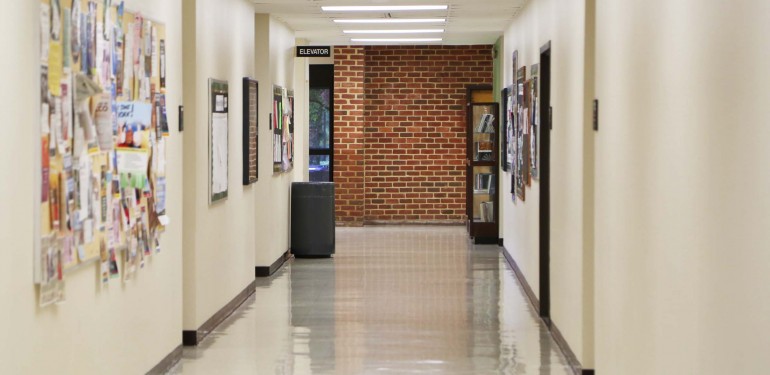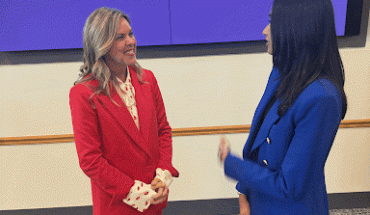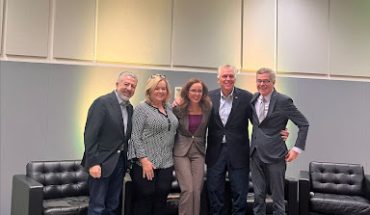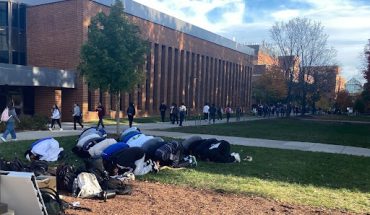(Credit: Songjun Deng/Fourth Estate)
The presence of hazardous materials, such as lead and asbestos, is one of the reasons Mason is requesting funding for the planning, demolition and reconstruction of Robinson Hall.
According to Virginia’s Six-Year Capital Outlay Plan, Robinson Hall’s health risks come primarily from the presence of asbestos and potentially lead-containing paint.
“The Capital Budget request for the Robinson Hall project cites hazardous materials within the building as one of many reasons for constructing a new building, rather than renovating the existing buildings,” said Paul Didier, director of Environmental Health & Safety at Mason. “Since much of the ACBM (asbestos-containing building materials) and original painted surfaces in the buildings have been enclosed or encapsulated, removal of these materials as part of a renovation project would potentially create more potential exposures than replacing the building.”
The Virginia Six-Year Capital Outlay plan establishes a revised six-year capital outlay plan for projects to be funded entirely or partially from general fund-supported resources, according to Virginia’s Legislative Information System website.
Asbestos is a class of naturally occurring fibrous minerals that are used commercially, especially in many building materials, because they are resistant to fire, chemicals and heat, according to the National Cancer Institute. Asbestos is also a human carcinogen, a substance confirmed to cause cancer. Increased exposure to or ingestion of these fibers can increase the risk of lung cancer, asbestosis and mesothelioma, which is a cancer of the membranes that line the chest and abdomen and is most commonly associated with asbestos.
“Although the Environmental Protection Agency (EPA) initiated a phase-out of asbestos for most commercial uses in 1981, and most historical uses were abandoned by manufacturers and builders in the 1980s, asbestos is still used in the manufacturing of some industrial products even today,” Didier said. “ACBM remain in many schools, homes and commercial buildings, including in Robinson Hall A and B.”
According to Didier, ACBM are not hazardous unless they become friable, meaning that they are fragile enough to be crumbled, pulverized or reduced to powder by hand pressure. The ACBM identified in Robinson Hall are not friable.
Another potentially hazardous material cited in the Capital Outlay Plan is lead paint, which is a paint that uses the toxic metal as an additive. According to Didier, lead paint was widely used until the 1970s but was later identified as a poisonous toxin. It was banned from residential use in 1978.
According to the U.S. Department of Housing and Development (HUD), lead poisoning can damage vital organs like the brain and kidneys. Children and adults are at risk of becoming poisoned if they consume contaminated objects or touch contaminated hands to their mouths. The risk of poisoning in homes and buildings constructed before 1978 can be lowered by regularly wiping down flat surfaces, washing hands, discarding loose paint chips and taking precautions of lead dust when renovating.
Although traces of lead paint have not been found in Robinson Hall, the university assumes that the material was used during its 1975 construction. Any risk of lead poisoning would be low, however, because according to Didier, many of the walls and doors have been repainted multiple times, covering the original paint, and are kept in good condition.
Several other buildings on campus were built during the 1970s and are presumed to contain similar hazardous materials. However, students, faculty and staff are not at an increased risk when using Robinson Hall and the other buildings. According to Didier, the university maintains the hazardous materials within the applicable guidelines and any identified hazard is taken care of by licensed abatement personnel, who also remove the materials during planned renovations when possible.
Former laboratories in Robinson Hall also contained hazardous chemicals, but the labs were cleaned out and decommissioned after closure, said Didier.




